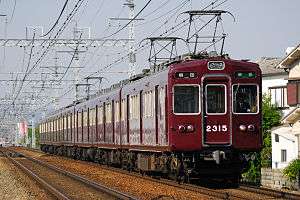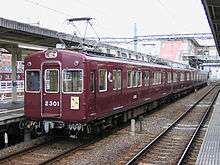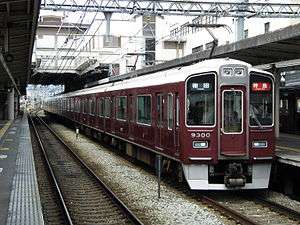Hankyu 2300 series
| Hankyu 2300 series | |
|---|---|
 A 2300 series on a Semi-express service, April 2007 | |
| In service | 1960–2015 |
| Manufacturer | Naniwa Kōki |
| Number built | 78 vehicles |
| Number in service | None |
| Number preserved | 2 vehicles |
| Number scrapped | 76 vehicles |
| Formation | 7 (formerly 2/3/4/5/6) cars per trainset |
| Operator(s) | Hankyu Railway |
| Depot(s) | Katsura |
| Line(s) served |
Hankyu Kyoto Main Line Hankyu Senri Line |
| Specifications | |
| Car body construction | Steel |
| Car length | 19,000 mm (62 ft 4 in) |
| Width | 2,808 mm (9 ft 2.6 in) |
| Height | 4,120 mm (13 ft 6 in) |
| Doors | 3 pairs per side |
| Maximum speed | 110 km/h (70 mph) |
| Traction system | Field chopper control |
| Electric system(s) | 1,500 V DC |
| Current collection method | Overhead catenary |
| Braking system(s) |
Regenerative brake electro-pneumatic brake |
| Safety system(s) | ATS |
| Coupling system | Knuckle-Type |
| Track gauge | 1,435 mm (4 ft 8 1⁄2 in) |

2300 series train in original style, March 2005
The Hankyu 2300 series (阪急電鉄2300系) was an electric multiple unit (EMU) train type operated in Japan by the private railway operator Hankyu Railway from 1960 until March 2015. It was the recipient of the inaugural Laurel Prize presented by the Japan Railfan Club in 1961.
Formations
| Car No. | 1 | 2 | 3 | 4 | 5 | 6 | 7 |
|---|---|---|---|---|---|---|---|
| Designation | Mc | M' | To | Mo | M' | T | Tc |
| Numbering | 2300 | 2330 | 2350 | 2300 | 2330 | 2380 | 2350 |
- The "Mc" and "Mo" cars were each fitted with two lozenge-type pantographs.
Interior
Passenger accommodation consisted of longitudinal bench seating throughout.
 Laurel Prize Award plaque
Laurel Prize Award plaque
Withdrawal
The final set in service operated until 20 March 2015.[1]
References
| Wikimedia Commons has media related to Hankyu 2300 series. |
- ↑ 阪急電鉄2300系引退でイベント [Hankyu 2300 series retirement events]. Tetsudo Hobidas (in Japanese). Japan: Neko Publishing Co., Ltd. 13 February 2015. Retrieved 13 February 2015.
Further reading
- Shinohara, Susumu (May 2015). 阪急2300系の55年 [55 years of the Hankyu 2300 series]. Japan Railfan Magazine (in Japanese). Vol. 55 no. 649. Japan: Koyusha Co., Ltd. pp. 100–107.
This article is issued from
Wikipedia.
The text is licensed under Creative Commons - Attribution - Sharealike.
Additional terms may apply for the media files.
